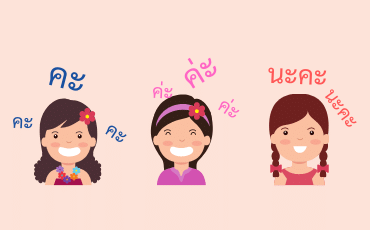In this lesson, we will learn the differences between คะ, ค่ะ, and นะคะ (ká, kâ, and ná ká). These are polite particles that women add at the back of sentences. Even some Thais get a little confused with these three because we forget the reading rule and we ending up writing ค๊ะ with ๊ which is not possible according to the reading rule and is also redundant.
Enough with the rule, let’s take a look at the differences between คะ, ค่ะ, and นะคะ.

คะ ká
คะ has a high tone and is used when asking questions or calling for attention politely.
Examples:
- Like this right ka?
แบบนี้ใช่ไหมคะ
bàep née châi măi ká - Do you understand ka?
เข้าใจไหมคะ
kâo jai măi ká - What should we do ka?
ทำอะไรกันคะ
tam à-rai gan ká - Auntie ka, let me order the food.
ป้าคะ สั่งอาหารหน่อย
bpâa ká · sàng aa-hăan nòi - How are you ka?
สบายดีไหมคะ
sà-baai dee măi ká
ค่ะ kâ
ค่ะ has a falling tone but is commonly pronounced with a low tone. ค่ะ is used in a statement as a response to an answer or in agreement.
Example:
- Hello ka.
สวัสดีค่ะ
sà-wàt-dee kâ - Thank you ka.
ขอบคุณค่ะ
kòp kun kâ - I don’t agree ka.
ไม่เห็นด้วยคะ
mâi hĕn dûay ká - No ka.
ไม่ใช่ค่ะ
mâi châi kâ - I don’t know ka.
ไม่ทราบคะ
mâi sâap ká
นะคะ ná ká
นะคะ has a high tone and is used just like ค่ะ but sounds more polite and friendlier.
Example
- Thank you na ka.
ขอบคุณมากนะคะ
nèung kòp kun mâak ná ká - If you don’t know tell me na ka.
ไม่รู้ก็บอกได้นะคะ
mâi róo gôr bòk dâai ná ká - Tell me where it hurts na ka.
เจ็บตรงไหนก็บอกนะคะ
jèp dtrong năi gôr bòk ná ká - I will go back first na ka.
กลับก่อนนะคะ
glàp gòn ná ká - Agreed na ka.
เห็นด้วยนะคะ
hĕn dûay ná ká
Now that you learned how to use คะ, ค่ะ, นะคะ you can go ahead and chat with your friends.

